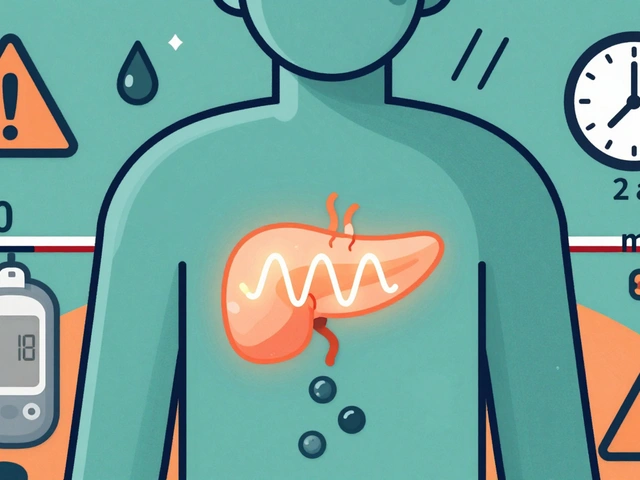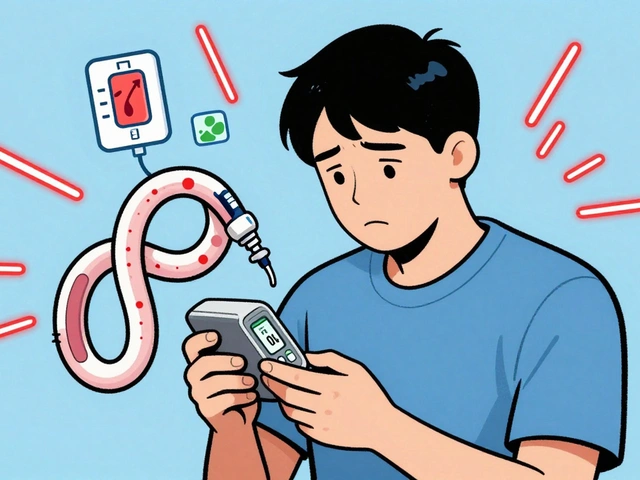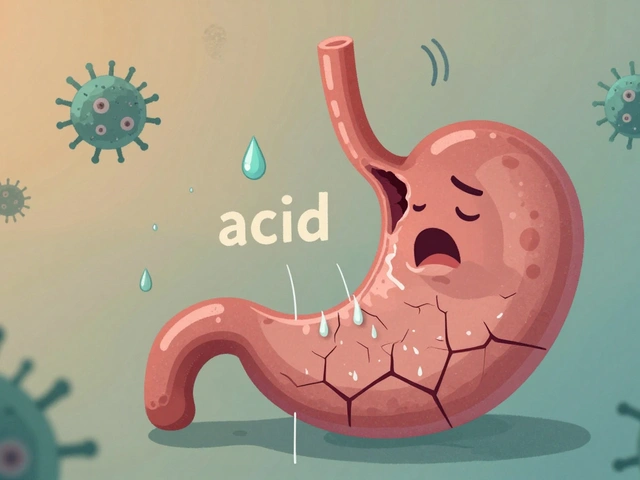
When you’re struggling with depression and standard antidepressants haven’t worked, your doctor might suggest Emsam (selegiline). It’s not your typical pill. It’s a patch you wear on your skin, and it works differently than most other antidepressants. But it’s not the only option. If you’re considering Emsam, you’re probably weighing it against other treatments - and that’s smart. Not every drug fits every person, and side effects, lifestyle, and effectiveness all matter.
What Emsam Actually Does
Emsam contains selegiline, a type of antidepressant called a monoamine oxidase inhibitor (MAOI). MAOIs have been around since the 1950s, but they got a bad reputation because early versions required strict diets and had dangerous interactions. Emsam changed that. The patch delivers selegiline through the skin, and at the lowest dose (6 mg/24 hours), it doesn’t require you to avoid foods like aged cheese, cured meats, or red wine. That’s a big deal. Most people on this dose can eat normally.
At higher doses (9 mg and 12 mg), dietary restrictions kick in again. But even then, Emsam’s patch form means steady drug levels in your blood - no spikes or crashes like with pills you take twice a day. That can mean fewer side effects like dizziness or nausea. Studies show Emsam works as well as other antidepressants for major depression, especially when people haven’t responded to SSRIs like sertraline or fluoxetine.
How Emsam Compares to Other MAOIs
There are other MAOIs, but they’re all pills and come with more restrictions. Phenelzine (Nardil) and tranylcypromine (Parnate) are the two most common. Both require you to avoid tyramine-rich foods no matter the dose. Tyramine can cause dangerous spikes in blood pressure when MAO-A is blocked. Emsam at 6 mg avoids this because it selectively targets MAO-B in the gut, leaving MAO-A in the liver mostly untouched.
But here’s the catch: if you need more than 6 mg, you lose that advantage. At 9 mg and 12 mg, Emsam stops being selective and blocks MAO-A too - so now you’re back to the old diet rules. That makes Emsam’s benefit mostly limited to the lowest dose. If you need a stronger dose, Nardil or Parnate might be just as effective - but you’ll have to plan your meals carefully.
SSRIs and SNRIs: The First-Line Options
Most doctors start with SSRIs (like escitalopram, sertraline) or SNRIs (like venlafaxine, duloxetine). These are easier to use. No diet changes. Fewer drug interactions. They’re the go-to for a reason: they work for about 60% of people with depression.
But if you’ve tried two or three SSRIs/SNRIs and nothing stuck, that’s when Emsam comes in. Research from the Journal of Clinical Psychiatry shows that about 30% of people who didn’t respond to SSRIs saw improvement with selegiline. That’s not a guarantee, but it’s a real chance.
SSRIs and SNRIs also have side effects - weight gain, sexual dysfunction, nausea - but they’re usually milder than MAOIs. Emsam’s most common side effects are skin irritation where the patch is applied, insomnia, and dizziness. If you’re sensitive to skin patches, that’s a problem. If you hate taking pills at specific times, Emsam’s once-daily patch might be better.
Other Patch-Based Options: Transdermal Bupropion
Bupropion is usually taken as a pill (Wellbutrin), but there’s also a patch version called Aplenzin. It’s not an MAOI. It works by boosting dopamine and norepinephrine. It doesn’t require dietary changes. It’s often used for depression with low energy or fatigue. It’s also used for smoking cessation.
Compared to Emsam, bupropion patches are less likely to cause insomnia or dizziness, but they can increase anxiety or cause dry mouth. They’re also less effective for people with severe depression or anxiety symptoms. If you’re looking for something that won’t interfere with your diet and you’re not responding to SSRIs, bupropion patch is a solid alternative - especially if you’re also trying to quit smoking.

Atypical Antidepressants: Mirtazapine and Vortioxetine
Mirtazapine (Remeron) works on serotonin and norepinephrine receptors, but it also blocks histamine - which is why many people feel sleepy on it. That can be good if you struggle with insomnia, bad if you’re already tired all day. It often causes weight gain, which is a downside for some.
Vortioxetine (Trintellix) is newer. It doesn’t just affect serotonin - it modulates several serotonin receptors. It’s less likely to cause weight gain or sexual side effects than SSRIs. Studies show it helps with brain fog and trouble concentrating, which are common in depression. It doesn’t require diet changes, and it’s taken as a pill once a day.
If your main issue is mental sluggishness or poor focus, vortioxetine might be better than Emsam. If you’ve had sexual side effects with other drugs, vortioxetine is often a better choice. But if you’ve tried multiple pills already and need something different in delivery, Emsam’s patch still stands out.
What About Ketamine and Esketamine?
Ketamine and its nasal spray form, esketamine (Spravato), are newer options for treatment-resistant depression. They work fast - sometimes in hours or days, not weeks. But they’re not for everyone. You have to take them in a clinic under supervision. They’re expensive. And they come with risks: dissociation, dizziness, increased blood pressure.
Emsam doesn’t need clinic visits. You apply it at home. It’s cheaper than esketamine. But it takes 2-4 weeks to work, just like other antidepressants. If you’re in crisis and need fast relief, esketamine wins. If you’re looking for a long-term, at-home solution with fewer logistical hurdles, Emsam still makes sense.
When Emsam Might Not Be Right for You
Emsam isn’t safe for everyone. If you have uncontrolled high blood pressure, heart disease, or liver problems, your doctor will likely avoid it. You can’t use Emsam if you’re taking other antidepressants, opioids like tramadol, or certain migraine meds (triptans). Stopping Emsam suddenly can cause withdrawal - dizziness, nausea, irritability. You need to taper off slowly.
Also, if you’re older or taking multiple medications, drug interactions become a bigger risk. Emsam can interact with over-the-counter cold medicines, herbal supplements like St. John’s wort, and even some painkillers. Always tell your doctor everything you’re taking - including what you buy at the pharmacy without a prescription.

Choosing Between Emsam and Alternatives: A Quick Guide
- Choose Emsam if: You’ve tried at least two SSRIs/SNRIs without success, you want a once-daily patch, you’re okay with mild skin irritation, and you’re on the lowest dose (6 mg) so you don’t need diet changes.
- Choose an SSRI/SNRI if: This is your first or second try. You want the simplest option with the least restrictions.
- Choose bupropion patch if: You have low energy, want to quit smoking, and want to avoid dietary rules.
- Choose vortioxetine if: Brain fog and poor focus are your biggest symptoms, and you want to avoid sexual side effects.
- Choose esketamine if: You’re in severe crisis and need fast relief - and you can access a clinic and afford the cost.
- Avoid Emsam if: You have uncontrolled hypertension, take opioids or triptans, or are on multiple medications that could interact.
Real-World Experience: What Patients Say
One patient, 52, tried sertraline, venlafaxine, and escitalopram. None helped. She started Emsam 6 mg and noticed a shift in mood after three weeks. She didn’t need to change her diet. The only issue was a rash under the patch - she switched sides weekly and it cleared up. She’s been on it for eight months now.
Another man, 68, was on Nardil for years. He hated the diet. When his doctor switched him to Emsam 12 mg, he had to go back to avoiding aged cheese and soy sauce. He said the patch was easier than swallowing pills, but the diet restrictions made him feel like he was back to square one.
These stories show there’s no one-size-fits-all. Emsam’s biggest advantage is convenience - the patch, the steady delivery, the low-dose freedom. But if you need higher doses, that advantage shrinks.
Final Thoughts: It’s About Fit, Not Just Effectiveness
There’s no single ‘best’ antidepressant. What works for someone else might not work for you. Emsam is a powerful tool, especially for people who’ve tried everything else. But it’s not magic. It has limits. Its biggest strength is the patch - no daily pills, no timing issues. Its biggest weakness is the dose-dependent diet rules.
If you’re considering Emsam, ask your doctor: What’s my goal? Is it convenience? Is it avoiding sexual side effects? Is it needing something after other drugs failed? Answer those honestly, and the right choice becomes clearer.
Can I drink alcohol while using Emsam?
At the lowest dose (6 mg/24 hours), moderate alcohol use is usually okay. But higher doses (9 mg and 12 mg) can increase the risk of high blood pressure when mixed with alcohol. Even at low doses, alcohol can make depression worse and increase dizziness or sleepiness. It’s safest to avoid alcohol entirely unless your doctor says otherwise.
How long does it take for Emsam to work?
Most people start noticing improvements in mood, energy, or sleep after 2 to 4 weeks. Full effects can take up to 6 to 8 weeks. Don’t stop the patch if you don’t feel better right away. If there’s no change after 8 weeks, talk to your doctor about adjusting your treatment.
Is Emsam safe for older adults?
Emsam can be used in older adults, but with caution. Seniors are more sensitive to side effects like dizziness, low blood pressure, and confusion. Doctors often start at the lowest dose and move slowly. It’s important to review all other medications, since older adults often take multiple drugs that can interact with selegiline.
Can I use Emsam with supplements like St. John’s wort?
No. St. John’s wort can cause a dangerous interaction with Emsam, leading to serotonin syndrome - a life-threatening condition with symptoms like high fever, rapid heartbeat, confusion, and muscle rigidity. Never combine Emsam with St. John’s wort, 5-HTP, L-tryptophan, or other serotonin-boosting supplements without your doctor’s approval.
What happens if I miss a patch change?
If you forget to change your patch, apply a new one as soon as you remember. Don’t double up the dose. If you miss more than 24 hours, contact your doctor. Stopping Emsam suddenly can cause withdrawal symptoms like dizziness, nausea, or irritability. Always taper off under medical supervision.






13 Comments
OMG I tried Emsam and it was like my brain finally remembered how to be happy 😭 No more crying in the shower, no more pretending I’m fine when I’m not. Skin rash? Pfft. I switched sides weekly and now I’m basically a new person. Also, I drank wine. And ate cheese. And did NOT die. 🧀🍷
Thank you for this comprehensive overview. As a clinician in Nigeria, I see many patients who discontinue antidepressants due to side effects or stigma. Emsam’s transdermal delivery offers a discreet option, particularly useful where pill adherence is challenging. However, access and cost remain significant barriers in low-resource settings. Always ensure patient education on dietary restrictions at higher doses.
So let me get this straight - you’re telling me the patch is great until you actually need to use it at a dose that makes you paranoid about your lunch? That’s not a treatment, that’s a trap with a sticker on it. 🤡
Have you considered that Emsam is just the pharmaceutical industry’s way of making you dependent on patches while they quietly phase out cheaper generics? The ‘diet-free’ low dose is a marketing gimmick. They know people will upgrade to 12mg and then panic about cheese. It’s all designed to keep you buying.
My cousin was on Emsam 6mg for 2 years after 5 failed SSRIs - she’s now hiking, painting, and even adopted a cat. The patch was a game-changer because she hated swallowing pills every day. Skin irritation? Yeah, but she rotated sites and used aloe vera. It’s not perfect, but it gave her life back. If you’ve tried everything else, don’t write it off just because it’s weird. Sometimes weird works.
Also, if you’re worried about alcohol - just be smart. One glass? Probably fine. Bottle of wine? Not cool. Depression already makes you vulnerable - don’t add more risk.
And yes, vortioxetine is great for brain fog. But if you’re tired of pills and want something that just… sticks? Literally? Emsam’s got heart.
MAOIs are dangerous and the FDA knows it they just let it slide because Big Pharma pays them off and now you’re all like oh my god the patch is so convenient but what about your liver what about your blood pressure what about the fact that your neighbor’s uncle died from a cheese reaction in 1998 and nobody talks about it anymore
Interesting breakdown. I’ve seen patients on Emsam 6mg do better than on SSRIs - especially those with atypical depression (sleeping all day, eating like a bear). The patch’s steady release helps with mood stability. But I always warn them: if you’re planning to eat blue cheese or drink red wine, don’t go above 6mg. That’s not a suggestion - it’s a safety line.
Also, bupropion patch is underrated. Great for smokers with depression. Less sedating than mirtazapine. Fewer sexual side effects than everything else. Worth a trial before jumping to MAOIs.
Depression treatment isn’t about finding the ‘best’ drug. It’s about finding the one that lets you live. Emsam’s patch isn’t magic - it’s just a different way of delivering chemistry. Some people need structure, others need simplicity. Some need silence, others need speed. The real question isn’t ‘which drug?’ - it’s ‘what kind of life are you trying to rebuild?’
I had a friend who tried everything - SSRIs, SNRIs, even TMS. Nothing worked. Then Emsam 6mg. She said it felt like the fog lifted slowly, like dawn coming after a long winter. She didn’t cry for the first time in 5 years. That’s not a miracle. That’s science. And yeah, the patch stuck to her back like a second skin - but she’d rather have a rash than a breakdown.
Let’s be real - Emsam is for people who can’t handle the discipline of taking pills. It’s the antidepressant equivalent of a smoothie instead of a balanced meal. Convenient? Sure. But is it deeper? No. The real work is in therapy, sleep hygiene, sunlight, and not scrolling TikTok at 3am. The patch is just a Band-Aid on a broken spine.
People don’t understand how dangerous MAOIs are. They think it’s just cheese and wine but what about the NyQuil? The Sudafed? The energy drinks? The herbal tea your aunt swears by? It’s a ticking time bomb wrapped in a patch and marketed as ‘revolutionary’ because the FDA is asleep at the wheel
Emsam works. I’ve seen it. Patch is easy. No pills. No timing. Just stick it on and forget it. But if you’re on other meds? Check interactions. Always. I don’t care how cool the patch looks. Your brain is not a lab experiment. Be smart.
Depression isn’t a chemical imbalance. It’s a story you’ve been telling yourself for too long. Emsam doesn’t fix the story. It just gives you a little more energy to rewrite it. The patch is just a tool. The real healing? That’s you. The walks. The journaling. The therapy. The decision to get out of bed even when your soul feels like wet cement. The patch? It just makes the first step less heavy.